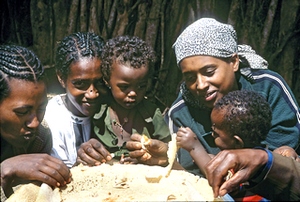Quality protein maize can reduce or prevent stunted growth in young children, according to a recently published study.
 In eastern and southern Africa, maize is the least expensive and most prevalent cereal crop, but quantity cannot make up for quality. A maize-dominated diet helps keep bellies full, but does not provide a balanced diet. Specifically, maize lacks the essential amino acids lysine and tryptophan necessary for efficient protein synthesis. Quality protein maize (QPM)—a type of maize with increased levels of those two crucial amino acids—is the focus of a recent CIMMYT co-authored publication based on two studies conducted in separate locations in Ethiopia1. The article delves into the role QPM can play in improving the nutritional status of young children in Ethiopia, where nearly 40% of children under five-years-old are underweight.
In eastern and southern Africa, maize is the least expensive and most prevalent cereal crop, but quantity cannot make up for quality. A maize-dominated diet helps keep bellies full, but does not provide a balanced diet. Specifically, maize lacks the essential amino acids lysine and tryptophan necessary for efficient protein synthesis. Quality protein maize (QPM)—a type of maize with increased levels of those two crucial amino acids—is the focus of a recent CIMMYT co-authored publication based on two studies conducted in separate locations in Ethiopia1. The article delves into the role QPM can play in improving the nutritional status of young children in Ethiopia, where nearly 40% of children under five-years-old are underweight.
The first of the two studies ran from August 2002-03, in Wama Bonaya District, and showed that children who consumed QPM had a 15% increase in the rate of growth in weight over those who consumed conventional maize. The second study took place from October 2005-06 in the neighboring Sibu Sire District. Here, children fed a QPM diet had a growth rate in height 15% greater than that of children who ate conventional maize.
Both study sites were selected to represent high maize-producing and -consuming areas with high levels of child malnutrition. Sites were also selected based on environmental factors, such as rainfall and altitude, and for ease of operation for conducting the study. For almost all (97%) of the 341 participating households, farming was their sole occupation. Average farm size was 1.2 hectares. In both districts, maize was the dominant food for children—in Wama Bonaya only 31% of families reported feeding their children foods other than maize, and in Sibu Sire 70% of the children regularly ate maize at least once a day. This highlights the vital role more nutritious maize could play in the future health and development of Ethiopian children.
Though there have been other studies on the effects and effectiveness of QPM (see Kernels with a kick: Quality protein maize improves child nutrition) this cumulative study varies slightly because it measures the effects of QPM when fully incorporated into the agricultural practices and home life of targeted households: study participants were given seed which they themselves grew and then prepared and consumed according to normal and locally-preferred practices, rather than being given pre-prepared QPM-based food products. This more closely mimics the impact QPM could have in a “real life” situation compared to some other previous study methods.
The study shows that although maize alone is not enough to sustain a nutrient-balanced diet, QPM can substantially improve the nutrition of children whose diets are, out of necessity, heavily based on one crop.
The paper was the result of collaboration among researchers Girma Akalu and Samson Taffesse of the Ethiopian Health and Nutrition Research Institute (EHNRI), Nilupa Gunaratna of the International Nutrition Foundation, and Hugo De Groote from CIMMYT-Kenya.
For more information: Hugo De Groote, agricultural economist (h.degroote@cgiar.org)
_________________________
Girma Akalu, Samson Taffesse, Nilupa S. Gunaratna, and Hugo De Groote. 2010. The effectiveness of quality protein maize in improving the nutritional status of young children in the Ethiopian highlands. Food and Nutrition Bulletin, 31(3): 418-430.
 Gender equality, youth and social inclusion
Gender equality, youth and social inclusion 
